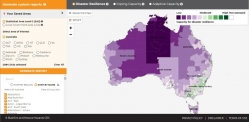news
Australian Disaster Resilience Index: A tool for resilience planning

08 September 2020
The the Bushfire and Natural Hazards CRC and the University of New England have developed an Australian Disaster Resilience index to help communities, governments and organisations plan for and adapt to and coping with natural hazards
The national index provides an interactive map that generates data reports for specific areas, and information about the strengths and barriers to disaster resilience for each area. A user can examine the resilience of a local community and start to plan for improved resilience.
The index provides area specific data on
Coping capacity:
- social character (the social and demographic characteristics of the community)
- economic capital (the economic characteristics of the community, such as wealth or market health)
- emergency services (the presence and resourcing of emergency services)
- planning and the built environment (the presence of legislation, plans, structures or codes to protect the
- community and its built environment)
- community capital (the cohesion and connectedness of the community)
- information access (the potential for the community to engage with natural hazard information).
Adaptive capacity:
- social and community engagement (the capacity within the community to adaptively learn and transform in the face of complex change)
- governance and leadership (the capacity within organisations to adaptively learn, review and adjust policies and procedures, or to transform organisational practices).
